Liliana Santamaria Hernandez
Liliana Santamaria Hernandez is an Administrative Coordinator with CIMMYT’s Global Maize Program, based in Mexico.
Liliana Santamaria Hernandez is an Administrative Coordinator with CIMMYT’s Global Maize Program, based in Mexico.
Aldo Rosales Nolasco is a Research Associate with CIMMYT’s Global Maize Program, based in Mexico.
Evelot Nyamutowa is a Research Associate with CIMMYT’s Global Maize Program, based in Zimbabwe.
Boniface Nyamande is a Field Auxilary with CIMMYT’s Global Maize Program, based in Zimbabwe.
David Ngure is a Research Associate with CIMMYT’s Global Maize Program, based in Kenya.
Patience Ndaruza is a Field Auxilary with CIMMYT’s Global Maize Program, based in Zimbabwe.
Melody Mutengezanwa is an Administrative Assistant with CIMMYT’s Global Maize Program, based in Zimbabwe.
Carlos Muñoz Zavala is an Assistant Research Associate with CIMMYT’s Global Maize Program, based in Mexico.
Gabriel Migwi is a Research Technician with CIMMYT’s Global Maize Program, based in Kenya.
A common approach toward data structuring is needed to improve access to gender research across agriculture data repositories, a recent report by the CGIAR Platform on Big Data in Agriculture suggests.
Simply adding the keyword ‘gender’ in database descriptions will improve the findability of gender agricultural research, which currently is hard to find due to the inconsistent use of keywords and tagging, said the report’s author Marcelo Tyszler, a (gender) data expert with the Royal Tropical Institute (KIT) in the Netherlands.
“The data is there. We just can’t find it all! A lack of consistent keywords when tagging research is leading to holes in searches for gender research across CGIAR, the world’s largest network of agricultural researchers,” he says.
“A more systematic and sharper use of keywords when describing datasets will improve findability in searches,” Tyszler states.
As part of the Findability of Gender Datasets report, researchers used a range of keywords, including ‘gender’, ‘women’ and ‘female,’ to search repositories for gender-based data across CGIAR agricultural research centers and compared the search results with a reference list of gender datasets provided by scientists. The results showed that a number of the datasets in the reference list were not found using these search terms.
The results uncovered important inconsistencies in the description of gender research, especially in terms of how data is structured and the detail of documentation provided in CGIAR repositories, says co-author Ewen Le Borgne, a KIT gender researcher.
“Poor data management limits the impact of research to be found, read and incorporated into new research projects,” Le Borgne says, invoking the age old saying, “If a tree falls in a forest and no one is around to hear it, does it make a sound?”

The researchers used the findings to promote a standardized approach to tagging and describing their research.
“To improve findability and the impact of data, the gender community should develop a list of commonly agreed keywords that can be used to consistently describe gender research data sets,” Le Borgne explains.
Any dataset containing ‘sex-disaggregated’ data should indicate so in the keywords, said Tyszler. This is also important for non-gender researchers, to broaden the scope of their impact.
“By facilitating the tagging, findability and accessibility of quantitative and qualitative gender data we hope to facilitate mixed methods research by providing opportunities for both qualitative and quantitative researchers to exchange insights and create a stronger dialogue,” he explains.
Moreover, across the CGIAR there is a wealth of gender specific qualitative data collected through focus groups, interviews and other participatory research. As CGIAR continues to advance gender research efforts, big data is unearthing exciting opportunities for understanding and acting on the relationships among gender, agriculture, and rapidly digitizing economies and societies. However, varied approaches to data management is restricting access, thus limiting the impact data can have when other researchers aim to reuse results to gain deeper insights.
Moving beyond the ‘gender’ tag

Not surprisingly, ‘gender’ was the most common keyword used to describe data found in the study. Although it is essential for researchers to add the ‘gender’ keyword to research descriptions they must also go further in describing what the dataset represents, the researchers indicated.
“‘Gender’ is not precise enough a keyword to find all relevant gender-focused datasets. However, our search shows very few details as to what, about gender, is studied in each project,” says Tyszler.
Studies in other fields, for example nutrition, seem to have much more granularity in the description, with keywords including, nutrient intake, nutrition policy, micronutrient deficiencies, etc. We need a movement like this in gender research, he explained.
Better keywords should be a minimum, but it is also possible to consider the identification of a set of smart ‘gender metadata fields’. These would be input elements that need to be filled in that could ensure all CGIAR datasets properly assess gender dimensions, which would boost the visibility of gender research.
Working as part of the CGIAR Socio-Economic Data Community of Practice, the gender researchers support the exchange of gender-focused data collection tools, with standardized focus groups and interview questions, to improve the potential for comparing different datasets.
Since 2018, the CGIAR Platform for Big Data in Agriculture and CGIAR Collaborative Platform for Gender Research have been collaborating out of mutual interest, to identify ways to unlock the big data potential of gender research.
Together they aim to take a much more active role in shaping up how gender data can be better analysed and reveal new insights, said Gideon Kruseman, the lead of the CGIAR Socio-Economic Data Community of Practice.
“We are promoting a standardized approach by bringing together gender data experts with other socio-economic and even biophysical scientists that may not know how to best engage with gender research and data,” Kruseman explains.
Access the full Findability of Gender Datasets report, which was funded through a 2018 grant to KIT Royal Tropical Institute, by the Community of Practice on Socio-Economic Data with co-funding by the CGIAR Gender Platform.
Cover photo: A woman helps to install a drip irrigation pipe on a farm in Gujarat, India. (Credit: Hamish John Appleby, IWMI)
Post-harvest losses — which can range between 10-20% in major cereals — cause not only the loss of economic value of the food produced, but also the waste of scarce resources such as labor, land, and water, as well as non-renewable resources such as fertilizer and energy.
“High postharvest losses imply reduced grain yield, but with the same total greenhouse gas emission,” says Rabé Yahaya, a CIM/GIZ Integrated Expert working at the International Maize and Wheat Improvement Center (CIMMYT). “Reducing these losses reduces the yield-scaled global warming potential — total greenhouse gas emission per kilogram of grain — and contributes to climate change mitigation, as well as food security.”
A significant proportion of these losses are caused by late harvest due to labor shortages, with crops languishing in the field before farmers can retrieve them. Small and medium-sized machinery may seem like the answer, but many one or two-axe machines are often unable to reach the inner sections of rice and wheat fields because of limited road access, or the fact that they are simply too heavy to carry.
“As mechanized land preparation works outwards, inner fields get ready for harvest first, but without any applicated technical solution,” he explains.
Could motorized scythes be the answer? Yahaya thinks so.
The other scythe
Motorized scythes are hand-operated tools used for mowing grass or reaping crops. Though largely replaced by horse-drawn and tractor-mounted implements, they are still commonly used in some areas of Asia and Europe.
Models specifically adapted for harvesting rice and wheat have been commercially available in Africa for over two decades and currently sell for $150-350, presenting the lowest initial investment cost of all engine-driven solutions on the market. The motor scythe also boasts the lowest harvest cost per hectare and is portable enough to reach inner fields.
Despite its relative affordability, uptake in much of West Africa has been slow, as many farmers have found the 10kg machinery too heavy for sustained use.
“Studies carried out in Benin, Burkina Faso, Cote d’Ivoire and Mali show that this rapid fatigue is caused by incorrect handling of the machinery, including flawed posture,” Yahaya explains. “This is simply because most operators have never undertaken official training for operating the tool.”
In a bid to address this challenge, Yahaya has been collaborating with Elliott Dossou, Sali Atanga Ndindeng and Ernst Zippel — all scientists at AfricaRice — to design and test potential solutions. Their proposal for the development of a Service Provider Harvest (SPH) model has been shortlisted for the GIZ Innovation Fund 2020 award, from a GIZ/BMZ-supported Innovation Fund.
Cut for service
The approach focuses heavily on capacity development, with an initial nucleus group of trainers taking the lead on activities such as recruiting and contracting service providers, providing training on harvesting and threshing, supporting aftersales services such as machine maintenance and repair, and helping to determine the optimum harvest time.
Under the proposed model, each trainer will be responsible for a group of around 50 service providers, who will receive guidance on understanding their role, finance, creating a network of client farmers, machine maintenance and use.
In addition to the financial rewards and aftersales services, the training opportunities will make this technology accessible to young entrepreneurs in rural areas. Earning up to $18 a day for harvesting and weeding services, those using the tool can expect to see a return on their initial investment in one to two months.
“Young people are the main prospective clients for this initiative,” says Yahaya. “With the motor scythe and related training, they can start earning serious money.” He stresses, however, that all farmers – regardless of age or gender – will be able to benefit from the job creation opportunities this initiative provides.
The initiative has been shortlisted for the GIZ Innovation Fund 2020. If selected, funding from the accelerator program would support testing, the integration of GPS sensors into the tools, creation of a platform for bank security and Carbon Credit earning, other technical activities.
Farmers in the Bale area, in Ethiopia’s Oromia region, mainly produce wheat and barley. Temam Mama was no different — but some six years ago, the introduction of the two-wheel tractor offered him additional opportunities. This was part of an initiative of the International Maize and Wheat Improvement Center (CIMMYT) and the Africa RISING project.
Selected as one of the two farmers in the region to test the technology, Temam took a five-day training course to understand the technology and the basics behind operating calibrating and maintaining the equipment.
The two-wheel tractor is multipurpose. By attaching various implements to a single engine, farmers can use it for ploughing, planting, water pumping, transportation, harvesting and threshing. For Temam, who had always relied on a rainfed agricultural system, the technology has high importance — he will be able to use the nearby river as a source of water for irrigation purposes.
To start off, Temam allocated 0.25 hectare from his four hectares of land for irrigation and planted potatoes for the first time. He was delighted with his harvest and the income he collected afterwards.
“From the first harvest, I was able to collect 112 quintals of potato and made roughly $1,529 in total,” said Temam.

Eternal returns
His productive journey had just started. This income allowed Temam to keep growing his business. He bought a horse and cart for $550 and taking the advice from the project team, he constructed a Diffused Light Storage (DLS) system to store his potatoes for longer.
To diversify his income, Temam occasionally provides transport services to other farmers. Over time, Temam’s financial capital has continued to grow, bringing new ideas and a desire to change. He went from a wooden fence to a corrugated iron sheet, to an additional three rooms by the side of his house for rentals.
He is fortunate for having access to the river and the road, he explains. He also sees new opportunities emerging as the demand for potato in the market continues to grow. The price for one quintal of potato sometimes reaches $76 and matching the demand is unthinkable without the two-wheel tractor, he says.
In addition to the two-wheel tractor, he has also bought a water pump to enable him to increase the area that he can grow irrigated potato, garlic and pepper on. His target is to have two hectares irrigated soon.
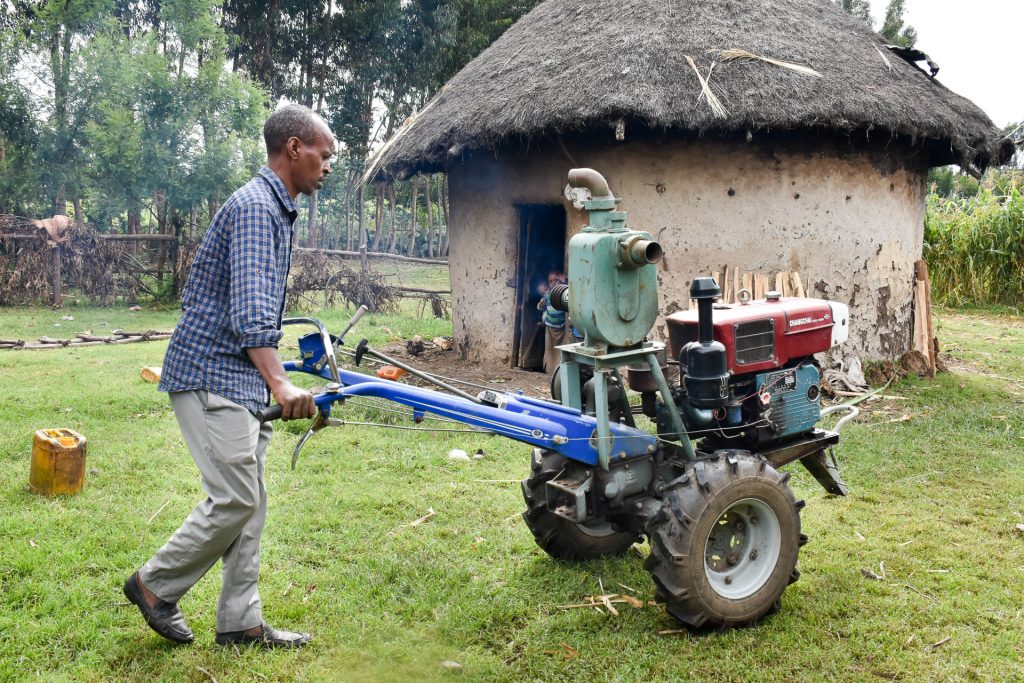
The future is bright
With his wife and four children, Temam is now living a well-deserved, healthy and exemplary life. Tomato, chilli and onion now grow on his farm ensuring a healthy diet, as well as diversified and nutritious food for the family. His economic status is also enabling him to support his community in times of need. “As part of my social responsibility, I have contributed around $152 for road and school constructions in our area,” noted Temam.
Under the Africa RISING project, Temam has proven that irrigation of high-value crops using two-wheel tractor pumping really works, and that it increases production and the profitability of farming. He has now stepped into a new journey with a bright future ahead of him.
“I plan to sell my indigenous cows to buy improved breeds and, in two to three years’ time, if I am called for refreshment training in Addis Ababa, I will arrive driving my own car,” concluded Temam.
Cover photo: Temam Mama’s family eats healthy and nutritious food produced through irrigation. (Photo: Simret Yasabu/CIMMYT)
Nearly 65,000 farmers in Nepal, 40% of which were women, have benefited from the Agronomy and Seed Systems Scaling project, according to a comprehensive new report. This project is part of the Cereals Systems Initiative for South Asia (CSISA), led by the International Maize and Wheat Improvement Center (CIMMYT) and supported by USAID.
One of the project’s most recent successes has been in accelerating the adoption of the nutritious and stress-tolerant mung bean in rice-wheat farming systems.
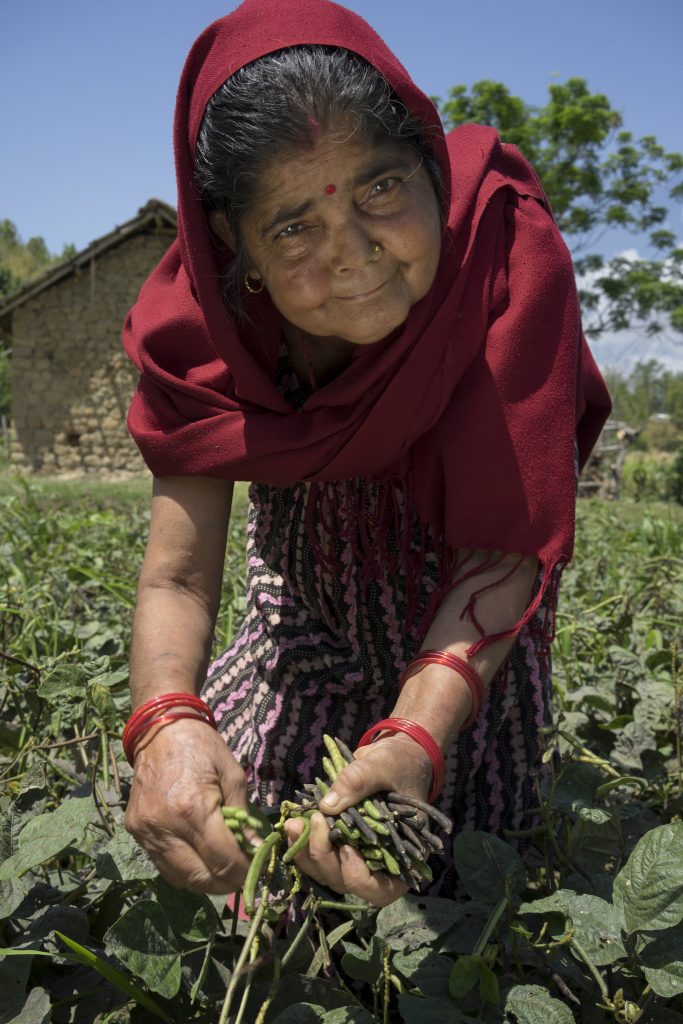
Rice-wheat is the dominant cropping system in the lowland region of Nepal. Farmers typically harvest wheat in March and transplant rice in July, leaving land fallow for up to 100 days. A growing body of evidence shows, however, that planting mung bean during this fallow period can assist in improving farmers’ farming systems and livelihoods.
“The mung bean has multiple benefits for farmers,” says Narayan Khanal, a researcher at CIMMYT. “The first benefit is nutrition: mung beans are very rich in iron, protein and are easily digestible. The second benefit is income: farmers can sell mung beans on the market for a higher price than most other legumes. The third benefit is improved soil health: mung beans fix the nitrogen from the atmosphere into the soil as well as improve soil organic content.”
Commonly used in dishes like dahl, soups and sprout, mung beans are a common ingredient in Asian cuisine. However, prior to the project, most farmers in Nepal had never seen the crop before and had no idea how to eat it. Encouraging them to grow the crop was not going to be an easy task.
Thanks to dedicated efforts by CIMMYT researchers, more than 8,000 farmers in Nepal are now cultivating mung bean on land that would otherwise be left fallow, producing over $1.75 million of mung bean per year.
The newfound enthusiasm for growing mung bean could not have been achieved without the help of local women’s farming groups, said Timothy J. Krupnik, CIMMYT senior scientist and CSISA project leader.
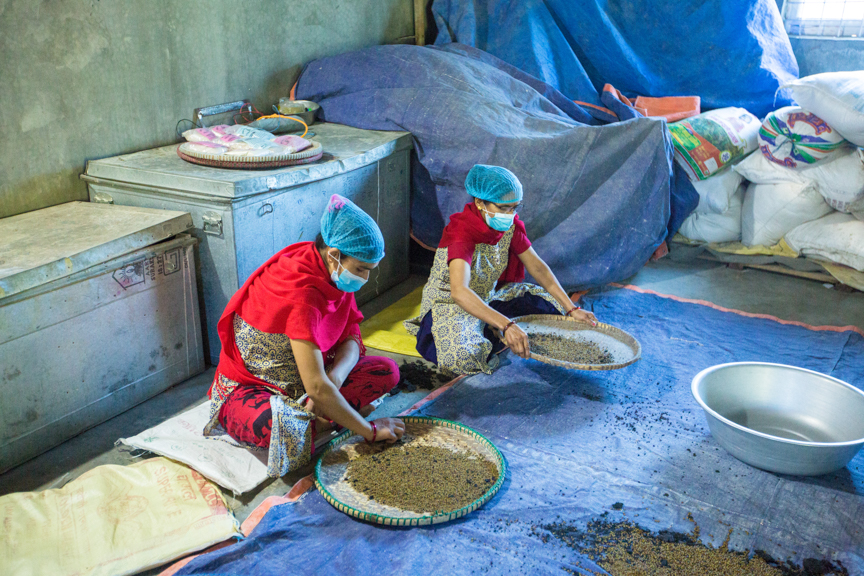
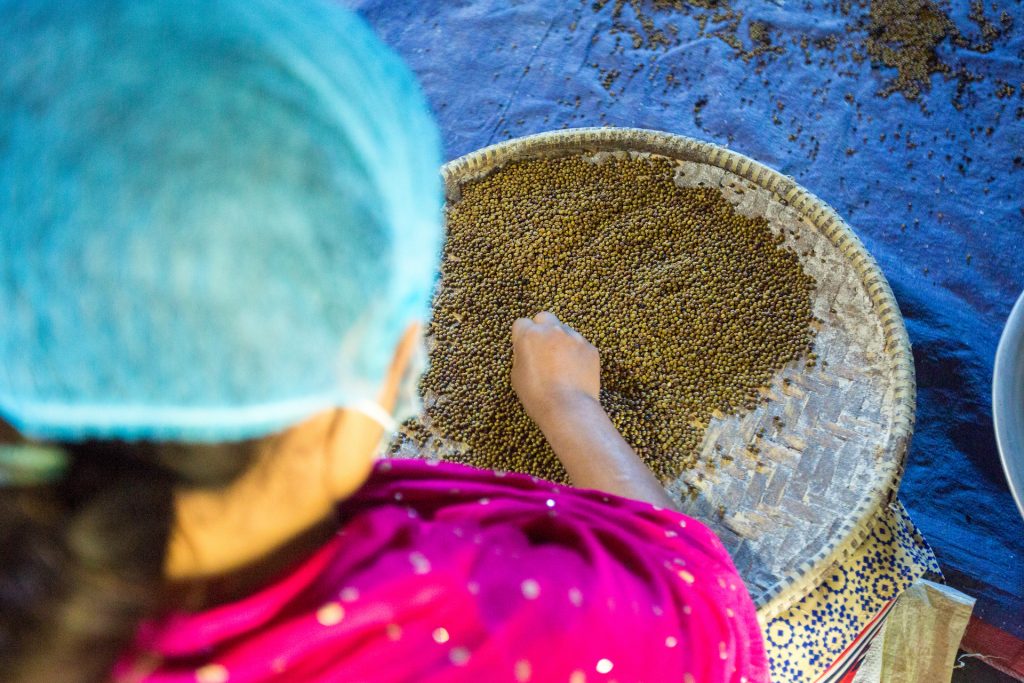
Bringing research and innovations to farmers’ fields
Introducing the mung bean crop to farmers’ fields was just one of the successes of Agronomy and Seed Systems Scaling, which was an added investment by USAID in the wider CSISA project, which began in 2014. The project aims to move agronomic and crop varietal research into real-world impact. It has helped farmers get better access to improved seeds and machinery and strengthened partnerships with the private sector, according to Khanal.
CSISA support in business mentoring and capacity building of seed companies to popularize newly released, biofortified and stress-tolerant wheat varieties has led to seed sales volumes tripling between 2014 to 2019. The project also led to a 68% increase in the number of new improved wheat varieties since the inception of the project.
Nepal’s National Wheat Research Program was able to fast track the release of the early maturing variety BL 4341, by combining data generated by the project through seed companies and the Nepal Agricultural Research Council (NARC) research station. Other varieties, including Borlaug 100 and NL 1327, are now in the pipeline.
Empowering women and facilitating women’s groups have been critical components of the project. Nepal has seen a mass exodus of young men farmers leaving the countryside for the city, leaving women to work the farms. CIMMYT worked with women farmer groups to expand and commercialize simple to use and affordable technologies, like precision seed and fertilizer spreaders.
Over 13,000 farmers have gained affordable access to and benefited from precision agriculture machinery such as two-wheel ‘hand tractors’ and ‘mini tillers.’ This is a major change for small and medium-scale farmers in South Asia who typically rely on low horsepower four-wheel tractors. The project also introduced an attachment for tractors for harvesting rice and wheat called the ‘reaper.’ This equipment helps to reduce the costs and drudgery of manual harvesting. In 2019, Nepal’s Terai region had almost 3,500 reapers, versus 22 in 2014.
To ensure the long-term success of the project, CSISA researchers have trained over 2,000 individuals from the private and public sector, and over 1,000 private organizations including machinery manufacturers and agricultural input dealers.
Researchers have trained project collaborators in both the public and private sector in seed systems, resilient varieties, better farming practices and appropriate agricultural mechanization business models. These partners have in turn passed this knowledge on to farmers, with considerable impact.
“The project’s outcomes demonstrates the importance of multi-year and integrated agricultural development efforts that are science-based, but which are designed in such a way to move research into impact and benefit farmers, by leveraging the skills and interests of Nepal’s public and private sector in unison,” said Krupnik.
“The outcomes from this project will continue to sustain, as the seed and market systems developed and nurtured by the project are anticipated to have long-lasting impact in Nepal,” he said.
Download the full report:
Cereal Systems Initiative for South Asia: Agronomy and Seed Systems Scaling. Final report (2014-2019)
The Cereal Systems Initiative for South Asia (CSISA) is led by the International Maize and Wheat Center (CIMMYT), implemented jointly with the International Food Policy Research Institute (IFPRI) and the International Rice Research Institute (IRRI). CSISA is funded by the U.S. Agency for International Development (USAID) and the Bill & Melinda Gates Foundation.
Cover photo: A member of a women farmers group serves a platter of mung bean dishes in Suklaphanta, Nepal. (Photo: Merit Maharajan/Amuse Communication)
Tonahuixtla, a small town located in Mexico’s state of Puebla, had suffered extreme environmental degradation due to deforestation and erosion. Agricultural land was in poor condition and the town had stopped producing many of their heirloom maize varieties, a loss to both biodiversity in the region and local culture. Poverty had increased, forcing many to migrate to bigger cities or to the United States for work. Those who were left behind, most of them women, had few ways to generate income to support their families.
Today, the story of Tonahuixtla is different. The town actively participates in reforestation and erosion-prevention activities. Landrace maize production is increasing, preserving the town and region’s biodiversity and customs. The residents have job opportunities that allow them to stay in their town and not migrate, all while preserving local biodiversity and protecting the environment.
What caused this change?
Corn husks.
Long considered a waste product, corn husks have been given a new lease on life through the Totomoxtle project. Named for the traditional indigenous Nahuatl word for corn husk, Totomoxtle turns the husks of native maize, found in a variety of colors, into a beautiful and sustainable veneer for furniture and walls. Founded by Mexican graphic designer Fernando Laposse, Totomoxtle has given farmers an incentive to plant native maize again, preserving invaluable biodiversity for future generations.
When Denise Costich, head of the maize collection of the germplasm bank at the International Maize and Wheat Improvement Center (CIMMYT), heard about the Totomoxtle project she knew she wanted to help. Passionate about preserving native maize, she and her team identified 16 landrace varieties from the CIMMYT maize collection that would produce husks in interesting colors and could grow well in the altitude and climate conditions of Tonahuixtla. She invited Laposse and project members to come visit the genebank and learn about CIMMYT’s work, and provided them with seed of the landraces they had identified.
“This is what we normally do in our work at the germplasm bank, we give people seed,” Costich said. “But this turned into a closer collaboration.”

Colorful collaboration
The maize germplasm bank team arranged for Totomoxtle project members to receive training in how to make controlled pollinations in the native maize varieties, at one of CIMMYT’s experimental stations.
“The technicians at CIMMYT’s Agua Fria station loved meeting the project members from Tonahuixtla, and immediately became passionate about the Totomoxtle project,” Costich said. “To this day, the technicians still save all of the colored corn husks from CIMMYT maize trials and send them to Tonahuixtla to provide them with additional material for their project.”
In the village of Tonahuixtla, project members — many of them women — work to iron the corn husks flat and glue them on to a stiff backing, then send them via courier to Laposse’s workshop in London where he uses them to create beautiful furniture and wall panels. This work allows the residents of Tonahuixtla to stay in their village and not be forced to migrate, all while preserving maize biodiversity and protecting the environment.
“Part of what this project is doing is also helping to keep families together — providing livelihoods so that people can stay in their communities, so that they don’t have to send all of their young people off to Mexico City or to the United States. To me, it’s really all connected,” Costich said.
The value of sustainability
The project also shows the intersection between biodiversity conservation and protecting the local environment. The maize husks used for the project are a sustainable and biodegradable material, and any residue from the maize husks that are not used for the Totomoxtle project are either fed to animals in the dry season or used to make fertilizer, which is then returned to the maize fields, a completely circular cycle in which nothing is wasted.
“I think that many of the communities that we work in really do understand the value and the importance of biodiversity,” Costich said. “In Tonahuixtla, the people are trying to reforest the hillsides in their region. They understand the connection between having no vegetation on the hills and having the rain water just roll right off the hills and into the temporary streams, thus losing that critically important resource. Over the years, as a result of the work they have done there, they have seen with their own eyes the improvement in the environment, not only that the hills are now covered with vegetation, but also they see a lot less runoff and erosion. I think that’s a really important lesson for everyone. I come from an ecology background, so I am always very excited to get involved in projects where it’s not just about maize, it’s about everything. It’s also about people’s lives, and nutrition, and the connections between them.”
Preserving local maize biodiversity is not just important for Tonahuixtla — it is important to all of humanity. Native maize varieties have adapted for thousands of years in farmers’ fields across Mesoamerica, developing natural resistance to local plant pests and diseases, as well as climatic conditions such as heat or drought. These native maize seeds, passed down generation to generation, could hold the key to developing improved maize varieties that can resist emerging maize diseases or extreme weather events related to climate change. If this biodiversity is lost, it represents a loss to global food security as a whole.
CIMMYT works to protect many of these native maize varieties in their germplasm bank, which is home to over 28,000 different collections of maize. Kept in cold storage under optimum conditions in the CIMMYT seed vault, these seeds are preserved for future generations and are available to anyone who needs them, including farmers such as those in Tonahuixtla, who had lost much of their native maize diversity.
“The biodiversity of cultivated plants is basically the guarantee for the future,” Costich said. “This is our security backup. Seed security is food security.”
Cover photo: Denise Costich (center, pink hat) stands with members of the Totomoxtle project and CIMMYT Germplasm Bank staff members near Tonahuixtla. (Photo: Provided by Denise Costich/CIMMYT)
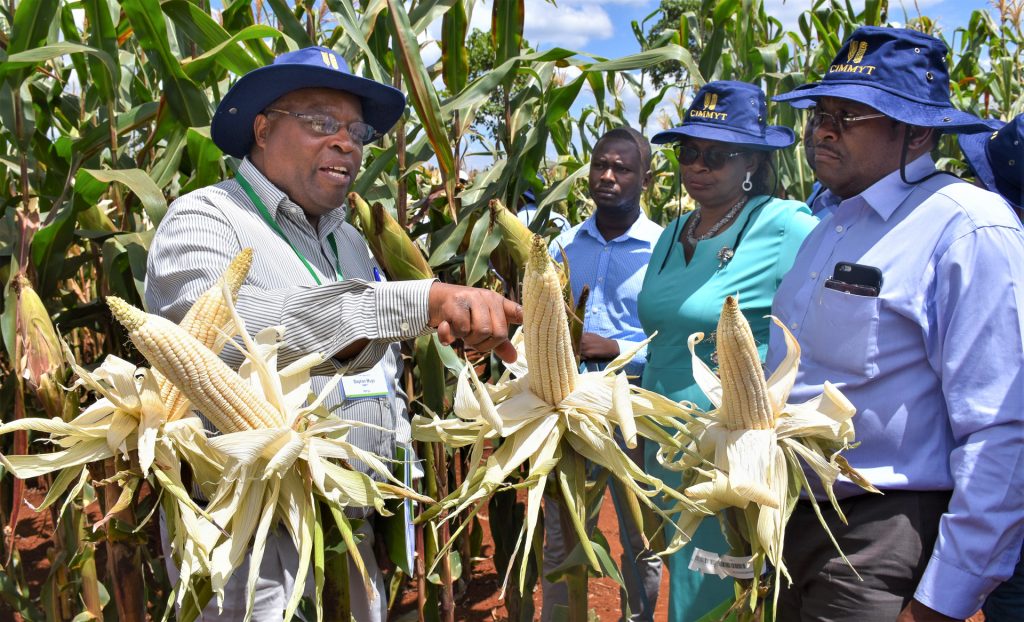
After a long and distinguished service as a maize breeder and senior manager at the International Maize and Wheat Improvement Center (CIMMYT), Stephen Mugo has retired from the organization. A Principal Scientist and Maize Breeder at CIMMYT’s Global Maize Program, Mugo also served as CIMMYT’s Country Representative for Kenya and CIMMYT’s Regional Representative for Africa.
He joined CIMMYT in 1998 as a post-doctoral fellow and his last day of work was on May 31, 2020. His colleagues honored him with memorable tributes at an online meeting held on May 21, 2020.
“Mugo has always demonstrated his commitment and determination, even in the most challenging times, for the benefit of CIMMYT and its staff. He has been a very productive scientist, maize breeder and project leader of several projects that have had great impact in the past. We are proud of what he has been doing and still does for CIMMYT,” said Director General Martin Kropff.
In his illustrious career, Mugo led the Stress Tolerant Maize for Africa Supplement Project (STMA-SUP) and the TELA Maize Project, both of which aimed at improving maize for drought tolerance and insect pest resistance in five countries in eastern and southern Africa. He was also the CIMMYT leader for the Water Efficient Maize for Africa (WEMA) project (2008-2018), Insect Resistant Maize for Africa (IRMA) project (1999-2004) and the Strengthening Seed Systems project in Kenya and Uganda (2001-2003).
“I leave CIMMYT with fond memories and with my head held high. I sincerely wish to thank my colleagues for being a wonderful team that continues to work hard to ensure that we get the right seed to the farmer,” Mugo said. “I have enjoyed every bit of my time at the organization. What I would request is that for us to continue working well together, we need to respect and treat one another the way you would like to be treated. This way, the organization would move from strength to strength,” he expressed.
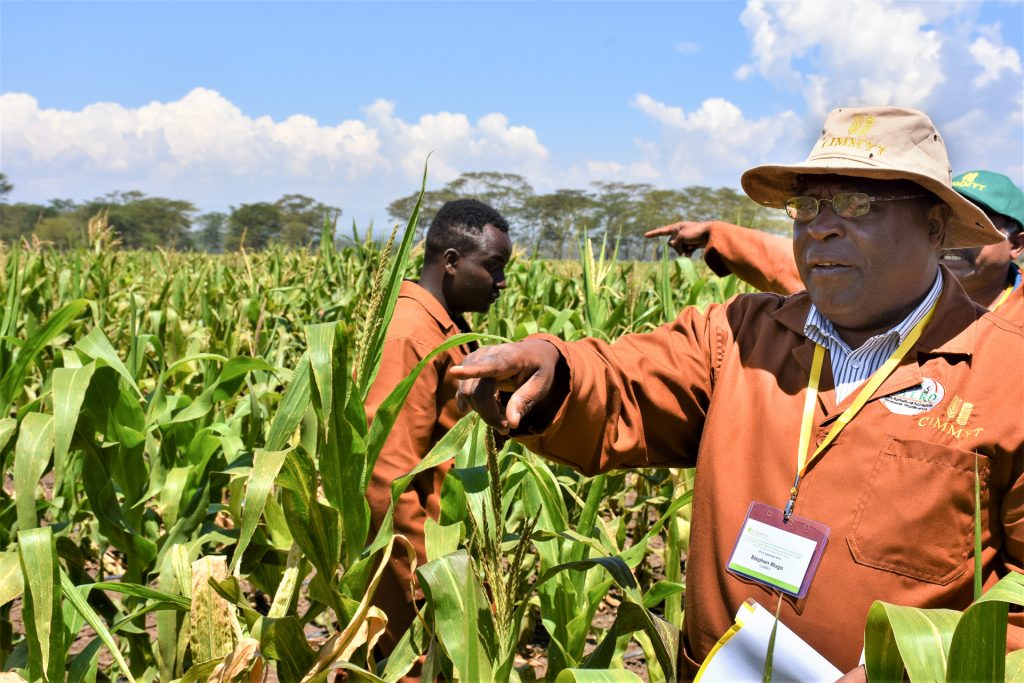
Mugo holds a PhD in Plant Breeding and Genetics from Cornell University and has published extensively in peer reviewed journals, with several book chapters to his name.
B.M. Prasanna, Director of the Global Maize Program at CIMMYT and the CGIAR Research Program on Maize (MAIZE) acknowledged the tremendous contribution that Mugo has made over the years in the projects he led.
“His work on the Insect Resistant Maize for Africa (IRMA) project has been phenomenally important, especially some of the germplasm that we are now finding as native genetic resistant to the fall armyworm,” Prasanna remarked. “He is a great champion and tremendous ambassador for CIMMYT’s work in Africa. I am sure he will continue to contribute to CIMMYT for years to come.”
Even though he leaves the stage, Mugo will provide consultancy support to CIMMYT, particularly on the MLN Gene Editing and TELA Maize projects.